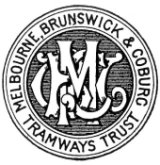Melbourne Tram Museum
- Follow Melbourne Tram Museum on Twitter
- Follow Melbourne Tram Museum on Facebook
- Follow Melbourne Tram Museum on Instagram
- Follow Melbourne Tram Museum on Pinterest
- Follow Melbourne Tram Museum on Tumblr
- Subscribe to Melbourne Tram Museum's RSS feed
- Email Melbourne Tram Museum
Penny fare to Pentridge: the Melbourne, Brunswick & Coburg Tramways Trust
The Melbourne, Brunswick & Coburg Tramways Trust only existed for six years. But in that time, although it was only a small concern with just over seven route miles, it became known as one of the most efficient and best run urban electric tramways in Australia. It achieved this accolade by a combination of careful and prudent planning, good technological choices, and above all sound and secure management by competent personnel.
There is no better recognition of this achievement than the prominence given to former MBCTT staff in its much larger successor, the Melbourne & Metropolitan Tramways Board, and in the survival of all the tramways built by the MBCTT in today’s Melbourne tramway system.
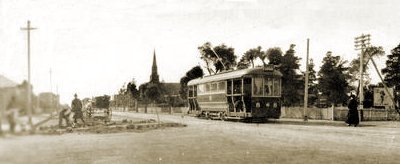 MBCTT
No 8 in Sydney Road, near Bell Street.
MBCTT
No 8 in Sydney Road, near Bell Street. - Photograph courtesy Coburg Historical Society.
Beginnings
The economic crash of the 1890s brought the expansion of Melbourne and its tramways to a crashing halt for the next 15 years. The northern suburbs were particularly hard-hit during this period. The Northern Tramway Company, which operated a horse tram along Sydney Road from the cable tram terminus at Moreland Road to Gaffney Street, went through liquidation in 1894 and a number of subsequent owner/operators, until it was acquired by Coburg Council in 1911.
By the beginning of the second decade of the twentieth century, the economy was rapidly improving, and electric tramways were being feted as an effective tool for promoting suburban development. Municipalities in the northern suburbs of Melbourne watched with interest the growing success of the Prahran & Malvern Tramways Trust, and determined that they too wished to use electric tramways to develop their suburbs and generate income.
Following conferences of the Brunswick and Coburg municipalities, the Brunswick and Coburg Tramways Act 1914 (No.2484) was passed by the State Government in February 1914, constituting the Brunswick & Coburg Tramways Trust. The Act provided for the construction, operation and management of an electric tramway within the areas of the two municipalities, and for the conversion of the Sydney Road horse tramway to electric traction.
The tramway was to commence from the cable tram terminus at Rathdowne and Park Streets, running west along Park Street before turning north up Lygon Street to Albion Street and along Holmes Road to the corner of Moreland Road. At this point a junction was formed; the mainline would proceed west along Moreland Road to Sydney Road and north as far as Bakers Road, whilst the branch line would continue northwards along Nicholson Street to Bell Street.
One of the key factors to ensure the success of the tramway was to capture traffic from the Melbourne CBD, and the promoters of the scheme wanted to avoid the financial problems encountered by the North Melbourne Electric Tramways & Lighting Company. This company’s line also started at a cable tram terminus, but the need for city-bound passengers to change cars was unpopular, and restricted its income and growth.
To bring the new electric tramway closer to the city, the Trust was enlarged by the inclusion of the City of Melbourne by an amending Act (No.2541) – the Melbourne, Brunswick and Coburg Act, on 26 Oct 1914, forming the Melbourne, Brunswick & Coburg Tramways Trust (MBCTT).
The tramway would no longer start at the Rathdowne Street cable tram terminus. Instead, it would continue down Lygon Street from Park Street to Elgin Street, then west to Madeline Street (the former name of the northern end of Swanston Street), and south down that street to the cable tram terminus at Queensberry Street.
Constitution of the Trust
The Melbourne, Brunswick and Coburg Tramways Trust consisted of seven members, two being elected by each of the Councils for two years [1]. The Chairman was elected by a conference of the Councils of the municipalities for a period of four years. In the event of a vacancy, the Minister of Public Works could appoint a person to that position.
Thomas O’Loghlen Reynolds, Mayor of Coburg in 1913, was unanimously elected Chairman of the Trust at a conference in February 1914, and was re-elected for a second four year term in 1918, thus remaining as the only Chairman for the entire life of the Trust. As required by the Act, he resigned his position as a councillor of the Coburg Council.
The time and place of the first meeting of the Trust was to be appointed by the Minister of Public Works by notice in the Government Gazette. The Trust was considered to be duly and legally constituted as a corporation from the appointed day (21 March 1914).
For the purposes of the Act, the Trust was to exercise the rights, powers and privileges of municipal councils, conferred on the Councils under the provisions of the Tramways Acts, 1890 and 1915. Among the functions, powers and obligations of the Trust were the following:
- Construct, manage and operate certain electric tramways in the municipal districts of the constituent councils.
- Purchase, produce, supply and use electric energy for the purpose of any tramway undertaking.
- Enter into contract with any person or any corporation, invest money in government or municipal debentures, and establish funds to provide for any of the employees in the event of sickness in an accident and to pay gratuities or retiring allowances to any of its employees.
- Lease tramways with the consent of the local Councils and the approval of the Governor-in-Council. The rent received was to be distributed between the municipalities (after payment of interest, repayment of money borrowed by the Trust and payment of other expenses of the Trust).
- Empowered to borrow money on overdraft from the bank up to ten thousand pounds. It could also borrow on debentures secured upon the security of the undertaking and upon the credit of the municipalities.
- Submit an annual balance sheet, showing its assets and liabilities and its revenue and expenditure to the local councils. The balance (if any) was to be divided between the municipalities. Deficiency of revenue was to be made good by the municipalities.
In the event of dissolution of the Trust (other than dissolution owing to the undertaking being acquired by a general tramway authority [2]) the surplus assets were to be divided among the municipal councils in proportion to their respective capital interests in the undertaking of the Trust.
Furthermore, the municipalities were required to indemnify the Trust against capital loss in the undertaking. In the event of any dispute between the municipalities and the Trust, the matter was to be settled by the Minister of Public Works.
Two key appointments were made in 1914. Charles Andrews, the Town Clerk and Treasurer of Coburg, was appointed as Secretary of the Trust — an appointment that, similar to that of the Chairman, lasted as long as the Trust itself.
The second appointment was that of Engineer, which went to Struan Robertson, formerly of Christchurch (New Zealand). At the time of his appointment he was the Electrical Engineer of the State Coal Mine at Wonthaggi. His expertise and energy would be shown to good effect during the construction phase of the trust. After the resignation of the horse tramway manager, W.F. Skinner, Robertson was also appointed Manager with a commensurate increase of salary of £100 to a total of £500.
Construction
Surveying of the route was completed by the close of September 1914, and detailed specifications drawn up for the ordering of material and services. Robertson’s experience was vital in ensuring that the contracts let against each set of specifications were delivered to requirements. Materials ordered from overseas were inspected by independent testing laboratories to ensure that quality was maintained, despite the substantial extra expense that this entailed.
Wartime conditions meant that significant delays were encountered with the delivery of rails. The manufacturer in the UK was diverted by the government into munitions work, and it was only through intervention via the Minister for Defence and the Australian High Commissioner in London that the production of the rail could proceed. There was further difficulty in arranging shipping of the rail to Australia, but this was also overcome in time.
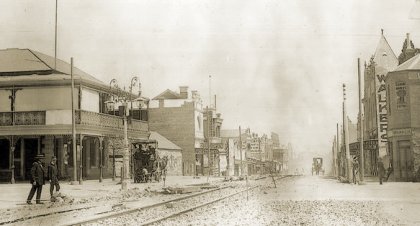 MBCTT
construction in Sydney Road.
MBCTT
construction in Sydney Road. - Photograph courtesy Coburg Historical Society.
Particular attention was made to providing a well-drained, high quality roadbed to support the track and road surface, as the Trust was obliged to maintain the road surface between the rails and for a distance 18 inches beyond the rails. The Melbourne City Council Engineer recommended ‘Gilsonite’, an asphalt based material, to provide the road surface, which was provided by the sole Australian agents, the Sim Paving Company. This company recommended that the vitrified bricks be laid against the rail to prevent the asphalt from breaking away from the rail head. Unfortunately, this was not successful due to shattering and subsidence of the bricks, so they were removed after less than four years.
The rail was laid to standard gauge using British Standard Section 90 lb per yard grooved rail on the straight sections, and 96 lb per yard on curves. Rail joints were initially welded using ferrignite (similar to the Thermite process) on about six miles of track [3]. The remaining rail joints were welded using oxyacetylene welding equipment. Joints that broke after the commencement of operations were repaired with the Trust’s electric arc welding equipment.
Despite the problems with the bricks, the attention to detail with regard to track construction resulted in reduced levels of maintenance being required. This was not the case with the contemporary Hawthorn Tramways Trust on the east side of the city, which had skimped on track construction to its vast detriment and cost.
Unlike other electric tramways in Melbourne, the Trust did not use centre poles to support the overhead. Instead, all overhead was supported by span wires suspended between pairs of roadside poles. Poles were a mix of steel and dressed ironbark, with about five miles of line using steel poles and the remainder timber, which were about £5 per pole cheaper than the steel poles.
Street lighting was supplied at stopping places within the cities of Brunswick and Coburg, together with some additional lights in Sydney Road Coburg. However, the City of Melbourne refused the right of the Trust to provide street lighting within the bounds of that municipality, as it already provided what it regarded as effective street lighting. Indeed, Lygon, Elgin and Madeline Streets were already amongst the best illuminated within the city.
Power was purchased from the Melbourne City Council Electric Supply Department. Duplicate high tension transmission lines were strung from the Council’s switch house in Sydney Road at Park Street in order to ensure continuity of supply. Unlike the PMTT and HTT, the Trust did not purchase power at the direct current bus bars, instead purchasing the high tension current three phase AC power at 6000 volts on a flat rate maximum demand tariff, operating its own substation. This provided significant savings to the Trust.
This was a major contributor to the Trust achieving the lowest operating cost per vehicle mile (7.96d) of any electric tramway in Australia.
The car depot and offices were constructed on land near the corner of Moreland Road and Nicholson Street, Coburg by the builder Robert Irvine. The depot was capable of holding 20 tramcars, and there was sufficient land on the freehold for accommodation for up to 80 tramcars, allowing for a significant amount of growth in the tram fleet. Also at the site were the substation, store and workshops, which were noted for being particularly well equipped.
The substation was equipped with two 200 kW rotary convertors for traction supply, and ancillary transformers to supply light and power for the workshop, and for street lighting. Unlike previous tramway substations in Melbourne, storage batteries were not installed to handle peak loads. Also, operation of the substation was automatic, removing the need for constant supervision. To handle the load from additional tramway traffic, another rotary convertor of 500kW capacity was installed during 1919.
The MBCTT made formal contact during the construction phase with both the Prahran & Malvern Tramways Trust and the Fitzroy, Northcote & Preston Tramways Trust, regarding issues such as construction standards and operational procedures.
Opening
The tramway was opened in four stages. This had a number of advantages, including some revenue was generated during the construction phase, and operations staff could be progressively trained during the intervening period. The dates for opening of the tramway were:
- 27 April 1916 – Sydney Road from Moreland Road to Bell Street;
- 14 May 1916 – Sydney Road from Bell Street to Bakers Road;
- 14 August 1916 – Sydney Road to Park Street; and
- 31 October 1916 – Nicholson Street branch, and Park Street to Queensberry Street.
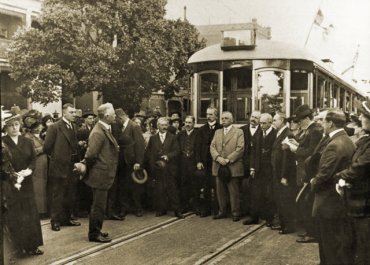 MBCTT
opening ceremony, 31 October 1916.
MBCTT
opening ceremony, 31 October 1916. - Photograph courtesy Coburg Historical Society.
The official opening ceremony was conducted on the final date at 3pm in the afternoon, although the ceremony was marred by a torrential rainstorm. The Minister for Public Works, the Hon. W. A. Adamson MLC, presided over the ceremony.
Operations
The main route of the tramway was divided into six sections:
- Queensberry Street to Princes Street
- Princes Street to Park Street
- Park Street to Albion Street
- Albion Street to Sydney Road via Holmes Road and Moreland Road
- Moreland Road to Bell Street
- Bell Street to Bakers Road.
The Nicholson Street branch consisted of a single section: Moreland Road to Bell Street.
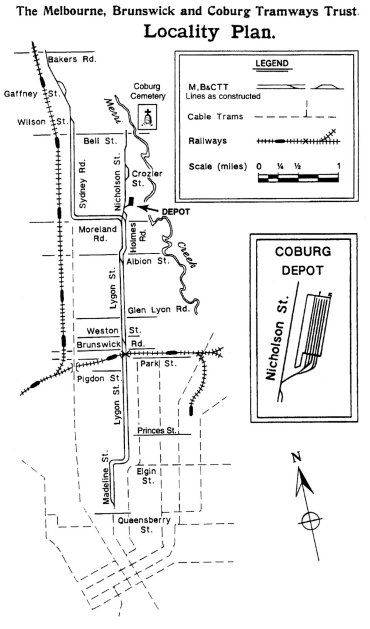 MBCTT
map of routes.
MBCTT
map of routes. - Source: after Prentice (see Bibliography).
The fare for each section was one penny, with the following exceptions:
- Blind persons travelled free, as long as their attendants paid the full adult fare.
- Children carried in arms under four years of age were not charged a fare.
- Children aged between four and twelve, and those under four not carried in arms, were charged 1d for travelling up to two sections, and 2d for three or more sections, provided that two children travelling together were not charged more than the fare payable by an adult for the same distance.
- School children under 18 could purchase monthly tickets, which would allow them to travel to or from school before 5:30pm weekdays and 1:30pm on Saturdays. Tickets cost 2s 6d for one to three sections, 4s 6d for four sections, or 5s for more than four sections. A refundable deposit of 1s was payable on these tickets.
- Transfer tickets of 2d were available to allow a single journey on the Tramways Board [4] cable trams Queensberry Street to City Road, South Melbourne. Similar transfer tickets were available on MTOC cable trams for travel in a northerly direction. Toorak and Brighton Road cable trams carried knifeboards indicating the connection with the Coburg trams.
- In order to prevent loss of custom to the Brunswick cable tram system, from March 1917 threepenny city return tickets were sold for travel from the corner of Moreland and Sydney Roads, but they were only available before 9am. Similar fourpenny return tickets for use from the corner of Bell Street and Sydney Road were made available from August 1918. Neither of these tickets were available on weekends, or entitled passengers to purchase cable tram transfer tickets. There was some complaints made to the Trust about the unavailability of similar return tickets from passengers travelling northwards, where upon the Trust replied that the tramway had been constructed for the benefit of residents of Coburg and Brunswick, and not for persons residing outside those areas.
Unlike the cable trams, which utilised the famous bell punch, the MBCTT issued tickets known as flimsies, which would also be the practice of the M&MTB across all its tramways. Over the life of the Trust, these were printed by a number of companies: JJ. Miller Printing Co, W.H. Osbourne, and Lamson Paragon Limited. The cable transfer tickets were printed by Sands & McDougall, who supplied all tickets for the cable tram system.
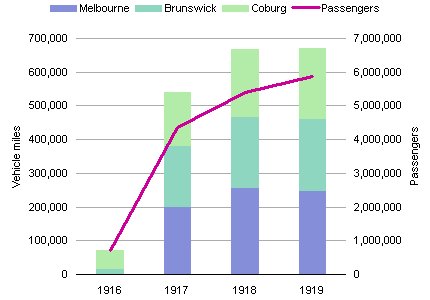 MBCTT
vehicle miles by municipality and passengers, 1916 to 1919.
MBCTT
vehicle miles by municipality and passengers, 1916 to 1919. - MBCTT annual reports 1916-19.
Although the Bakers Road was by far the busier line, weekend traffic on the Nicholson Street or Coburg Cemetery branch line was particularly heavy. Normal weekday operations would see about 200 fares paid on this line, although Saturdays would average 600 fares, with between 1000-2000 fares on Sundays depending on the weather conditions. This line was in the unusual position that there would be fewer weekday services (22) than weekends (42 on Saturdays and 32 on Sundays).
 The
tramway was notable for serving two major public institutions. The University
of Melbourne was located on Madeline Street between Grattan and Elgin
Streets. More notoriously, His Majesty’s Prison Pentridge [5]
was located in Coburg on Sydney Road just north of Bell Street. This
prominent institution was known as the Bluestone College, or sometimes
in latter years Coburg College, and would not close until 1997.
The
tramway was notable for serving two major public institutions. The University
of Melbourne was located on Madeline Street between Grattan and Elgin
Streets. More notoriously, His Majesty’s Prison Pentridge [5]
was located in Coburg on Sydney Road just north of Bell Street. This
prominent institution was known as the Bluestone College, or sometimes
in latter years Coburg College, and would not close until 1997.
One prisoner in Pentridge, Maxwell Charles Skinner, was notorious for commandeering a Coburg tram during one of his many escape attempts.
Tramcars displayed their destinations on blinds mounted in rooftop boxes. As a significant proportion of the population was illiterate, coloured symbols were displayed together with the destination in words, similar to the conventions used in Sydney and Adelaide at the time. In December 1916, the destination ‘Bell St E.’ used on the Nicholson Street branch was replaced with ‘Coburg Cemetery’ to avoid confusion with the ‘Bell St’ destination used on Sydney Road trams.
During 1918, display of the coloured symbols were abandoned concurrently with the removal of rooftop destination boxes, the blinds being moved to a position at the top of the driver’s near side window. Routes were then indicated at night by a display of two coloured lights, similar to that used on the PMTT and HTT.
Staff
The Trust employed about 25 salaried staff and 100 employees at the Depot. By 1920, the traffic staff required 33 drivers and 33 conductors to maintain a full roster, giving a total of about 191 staff and employees.
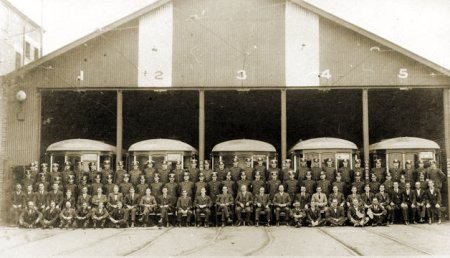 MBCTT
staff photograph 1918.
MBCTT
staff photograph 1918. - Photograph courtesy Coburg Historical Society.
The wages of traffic staff were tied to those of the PMTT by the enabling Act, which required a working week of 48 hours. Drivers were initially paid 48 shillings per week, and conductors 45 shillings for the same period. Overtime rates were set at time and a half. These wages compared favourably with unskilled labouring rates of 7 shillings per 8 hour day.
Wartime labour shortages and the booming economy led to substantial wage increases. By the end of 1919, drivers were being paid £3 15s for the same hours, and other employees were rewarded commensurately.
Struan Robertson resigned in May 1918 to take over management of the troubled Hawthorn Tramways Trust at an annual salary of £600. He was replaced as Engineer by Mark Westcott, who he had recruited two years previously as Works Superintendent. Westcott had previously been managing the Electrical Shop at the Municipal Tramways Trust in Adelaide. The Chairman assumed the role of Manager on Robertson’s departure.
In February 1917 a benevolent association, the Melbourne, Brunswick & Coburg Tramways Club, was founded to ‘promote sociability and fellowship in the service’ and to maintain a ‘sick, accident and funeral benevolent fund’ which also supported the various sporting and literary clubs associated with the Trust. A joining fee of 6d applied, with weekly dues of 3d thereafter. As from February 1918, under an agreement with the Trust, any conductors’ surpluses [6] were paid over into the club.
In addition, the men formed the Melbourne, Brunswick & Coburg Tramways
Band, employing a professional bandmaster and debuting in August 1917.
The band played at various locations along the tramway on weekend afternoons
and summer Sunday evenings, wearing their traffic uniforms. This attracted
additional weekend patronage to the tramway, and provided a substantial
benefit to the Trust.
Financial
While the Trust was a fairly small tramway operation, it was noted for obtaining particularly strong financial results. From reviewing annual reports, and reports on proposed tramway extensions, it is clear that the Trust management was focused on managing both operational and capital costs so that the tramway would not be a financial burden on the three constituent municipalities. The Trust management constantly searched for cost-saving initiatives, and was not averse to spending money on well-targeted projects to generate savings in the medium to long term.
The Trust’s borrowing powers provided for the raising of £200,000 through the issuing of debentures, and a further £10,000 was available on overdraft. It was able to negotiate a favourable interest rate of 4.5% with the Commonwealth Bank, to be applied only when the money was drawn down by the Trust. This was particularly convenient as the war time conditions meant that materials ordered from overseas were often delayed. Debentures were frequently redeemed through the Sinking Fund, thus reducing the total debt and interest payments.
The first few months of tramway operation in 1916 saw a small operating deficit, which was reimbursed by the municipalities of Coburg and Brunswick. The deficit was due to a collision between two of the trams (numbers 3 and 7) in Sydney Road on 25 May 1916, otherwise a surplus of £306 13s 7d would have been realised.
The first full year of operation, 1917, saw a healthy return on capital of about 2.1%, which improved slightly over the next two years. Clearly the MBCTT was a reasonable business proposition which justified the risk that the constituent municipalities had taken, given the interest rates of around 4.5 to 5% then in force.
The majority of the surpluses were allocated to the renewal and maintenance reserve accounts as a depreciation provision, which were required to be maintained at a level of 2.5% of capital value by the enabling legislation. The money that was available for distribution was divided on the basis of car miles run in each of the three municipalities.
However, the major advantage the tramway brought to the constituent municipalities, particularly Coburg and Brunswick, was the growing population and rise in residential property values through the presence of the tramway, which led directly to a rise in council income through increasing council property rates. Therefore, the relatively small surpluses distributed to the municipalities were not viewed as a negative, although no doubt they would have wished for larger distributions.
 MBCTT
No 6 opposite Pentridge Prison.
MBCTT
No 6 opposite Pentridge Prison. - Photograph courtesy Coburg Historical Society.
Rolling stock
The Trust’s initial rolling stock consisted of 12 single truck California cars built by Duncan & Fraser of Adelaide. The bodies were designed by Struan Robertson, and were the first in Melbourne to be fitted with air brakes.
The livery was based on a dark Paris green with white rocker panels and trim, and a grey roof. All brass fittings were polished and the lining, numbers and monograms were resplendent in aluminium silver leaf. The interior was finished in varnished native timbers, whilst the undergear was painted black.
Another six cars were ordered in 1916, also to be built by Duncan & Fraser. They were notable for utilising a radial truck (Brill Radiax) with a very long wheelbase to produce a superior ride quality. These six cars were of a different design by Robertson, with a long divided saloon and no motormen’s bulkheads. Additionally, these were the first trams in Melbourne to be fitted with underfloor line breakers for control of the main current supply, rather than the roof-mounted circuit breakers fitted in the driving compartments. This initiative significantly reduced the risk of fire and electric shocks in the tram.
However, there were strong common design elements between the two types of tramcars, so it was clear that they came from the hand of the same designer.
Unusually for this period, all trams were delivered with solid cast steel disc wheels, whereas all previous Melbourne electric trams had been fitted with spoked wheels with separate tyres.
The Trust originally ordered 13 complete sets of car equipment for the 12 cars, so that rapid changeover of parts could be achieved in the event of failure. However, after the delivery of the Radiax cars, there were spare cars available, so the equipment was used to build a works car in the Trust’s own workshops. Originally fitted as a line scraper car, it was also used for transporting materials to work sites, and as a breakdown car.
During March 1918, a works trailer for use with this tram was constructed from second-hand materials, including wheelsets from an old horse tram, for the cost of £150. It was estimated that the use of this car saved about £75 per annum.
A further six cars were ordered in 1918, however they were not to be delivered until well after the Trust had ceased to exist. Initially, they were to be the same design as the second tram order, but the Trust could not come to agreement with the local agent for the Radiax trucks, Noyes Brothers, and Brill would not sell direct to the Trust or through another agent, or allow local manufacture. Therefore, this order was to the same basic design as the initial 12 cars, but with line breakers in place of circuit breakers, and torpedo type roof ventilators as per the Radiax cars, rather than the original design.
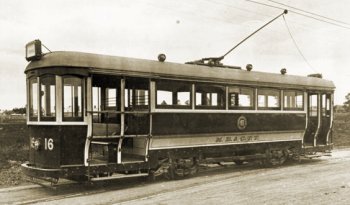 MBCTT
No 16.
MBCTT
No 16. - Photograph courtesy Public Record Office Victoria.
The tramcars in the Trust’s final order were to be numbered in
the range 19-24, but all entered service after the formation of the
M&MTB. In a premature renumbering exercise, the car that was to be number
22 was numbered 139, which was notionally allocated to the Eastern system
of the M&MTB. The following tram entered service as number 23, whilst
the car that was to be number 24 entered service as number 171. The
other cars in this order were subsequently renumbered as 166-170. The
tram that was to be permanently numbered by the M&MTB as 139 was the
first of the Q class cars.
After trials in 1918, all cars were fitted with double ended brake cylinders and improved brake rigging, applying two brake shoes to each wheel rather than the previous one. This provided superior braking performance and improved brake shoe life by 50%, as well as providing a reduction in power consumption. Designed by Mark Westcott and Struan Robertson, the new brake system was patented as number 6792 of 1918.
Proposed extensions
A number of extensions were proposed during the lifetime of the Trust.
An independent report was commissioned from consulting engineer V.J. Crowley of 99 Queen Street Melbourne and delivered in 1915. This concerned a line commencing at the corner of Queen and Flinders Streets and terminating at the corner of Gaffney and Sussex Streets in Coburg, roughly paralleling the current route 55 West Coburg line through Royal Park and following suburbs. A connecting line down Moreland Road to Sydney Road would provide access to the Trust’s system for car transfers. The total capital cost for the 8¼ mile tramway was projected at £123,900, generating an annual loss of £838 as the tramway was more developmental in nature. Based on these numbers it was decided not to proceed with this proposal.
The most hotly pursued extension was the conversion of the cable tram line to electric traction from the Queensberry Street terminus to the corner of Lonsdale Street and Swanston Street. Implementation of this extension would provide significant financial benefits to the Trust, as well as providing improved convenience to its customers. This proposal was vehemently rejected by the Melbourne representatives of the Trust on the grounds that the overhead wires would disfigure the city. However, Sir David Hennessy, one of the representatives of the City of Melbourne on the Trust, was also a member of the Melbourne Tramways Board which operated the cable tram system, so he suffered from some conflict of interest in this matter.
This proposal would not go away, and negotiations continued throughout the period 1916 to 1918, but the Government then decided that any further consideration would be deferred pending the implementation of a single tramway authority, and there the matter rested.
In 1916 it was proposed to extend the Bakers Road line a distance of one mile to the New Melbourne General Cemetery at Fawkner. The constituent councils agreed to indemnify the Trust up to a fixed amount against losses generated by the extension for a period of four years, and by 1918 all parties had agreed to the proposal. However, legislative assent was required, and the Chairman approached the Minister for Public Works for support. The Minister undertook to bring it to the attention of Cabinet with the intention of including the extension within the Tramways Bill currently under consideration. However, Cabinet decided that no tramway extensions would be approved until the Tramways Bill was passed through both Houses of Parliament.
Thus, Bakers Road remains the terminus of the Sydney Road line to this day.
Another proposed line was to run west from Sydney Road along Bell Street to terminate in Pascoe Vale at Cumberland Road, the 1¾ mile long single track line costing between £15,000 and £20,000. After some analysis by the Trust’s engineer, it was determined that the line would generate an operating loss of £1500 per annum, so no further progress was made.
The only extension actually carried out by the Trust was an 80 foot extension of the southern terminus across Queensberry Street, built in June 1918, to reduce the distance passengers had to walk when transferring between the cable tram and the Trust’s electric tram.
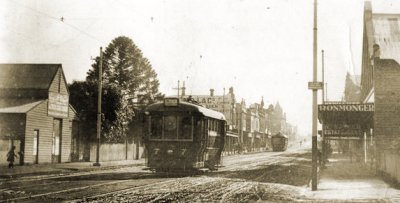 MBCTT
No 7 in Sydney Road, north from Page Street.
MBCTT
No 7 in Sydney Road, north from Page Street. - Photograph courtesy Coburg Historical Society.
Dissolution
In accordance with the provisions of the Melbourne and Metropolitan Tramways Act 1918 (No.2995) the Melbourne, Brunswick and Coburg Trust was dissolved and taken over by the Melbourne and Metropolitan Tramways Board on 2 February 1920.
The Chairman of the Trust was appointed as a member of the new Board, and the electric tramways taken over were divided into the Northern and Eastern systems for administrative purposes, with the MBCTT being allocated to the Northern system along with the Footscray Tramways Trust and the Fitzroy, Northcote & Preston Tramways Trust. Two former MBCTT officers were appointed as initial managers of the systems: Mark Westcott as manager of the Northern system, and Struan Robertson as manager of the Eastern system.
Today, the tramlines built by the Trust are their major legacy, all of which remain in use, although the routes using them are quite different to those operated by the trust.
A second running shed was added to Coburg Depot by the M&MTB. However, it was closed as a running depot on 11 October 1952 [7], being used for surplus tramcar storage for a number of years, until the M&MTB overhead department made it their home. The era of privatisation in the 1990s saw maintenance departments outsourced, so the depot became surplus to requirements. It then remained derelict for a number of years, haunted by squatters, until it was sold and demolished in 2007.
The only other reminder is the presence of Charles Bowden Reserve in Nicholson Street. This small park resulted from the compulsory acquisition from Elizabeth Bowden of a strip of land 360 feet long by 33 feet wide along the eastern side of Nicholson Street at Bell Street. The land was required to widen the roadway to allow traffic to get past the trams waiting at the terminus.
Two former MBCTT tramcars have survived and are on display at Hawthorn Depot: M&MTB S class 164 (formerly MBCTT 11) and T class 180 (formerly MBCTT No 16). Both of these cars are on loan from the Tramway Museum Society of Victoria.
Bibliography
MBCTT Annual Reports (1914-19)
Cross, N., Budd, D., and Wilson, R. (1993) Destination City (Fifth
Edition), Transit Australia Publishing
Crowley, V.J. (1915), Report on Proposed Tramway for the Melbourne,
Brunswick & Coburg Tramways Conference
Prentice, R. H. ‘A Brief History of the Melbourne, Brunswick and
Coburg Tramways Trust’ in Running Journal July 1966, Tramway
Museum Society of Victoria
Other sources
Public Records Office Victoria Series VA 2971 – Melbourne, Brunswick & Coburg Tramways Trust
Footnotes
[1] The members of the trust from each of the constituent councils with their terms in office were as follows:
Melbourne
Alderman Sir David V. Hennessy, Kt., JP (1914-20)
Alderman John Gardiner, JP (1914-20)
Brunswick
Councillor John Millward, JP (1914-20)
Councillor F.T. Hickford, MA (1914-18)
Councillor A.G. Wales, JP (1918-20)
Coburg
Councillor A.G. Campbell, JP (1914-16)
Councillor A.T. Hackett, JP (1914-16)
Councillor H.J. Richards, JP (1916-20)
Councillor A. Bush, JP (1916-18)
Councillor W.E. Cash, JP (1918-20)
[2] This clause clearly foresaw the formation of the Melbourne & Metropolitan Tramways Board in 1919, which was to take control of all tramways within the Melbourne area except those operated by Victorian Railways.
[3] The track mileage of the tramway was 1.77 miles of single track, and 5.26 miles of double track, giving a total single track mileage of 12.29 miles.
[4] The interim Melbourne Tramways Board had taken control of the cable tramway system from MTOC as from 1 July 1916. Sir David Hennessy was a member of the Tramways Board on behalf of the Melbourne City Council.
[5] Pentridge was the former name of the suburb of Coburg.
[6] A conductor’s surplus is any additional money left after a conductor’s shift after the amount for the tickets sold and the normal cash float is deducted from his total holdings. This amount is generated through overpayment of fares by passengers, usually as a result of provision of insufficient change. If the conductor’s end of shift balance was short after deduction of the cash float and amount for tickets sold, he was expected to make up the difference through deductions from his wages.
[7] Coburg Depot had the second shortest operating life (36 years) of any Melbourne electric tram depot (excluding the Box Hill to Doncaster tramway), just being pipped by Preston (Thornbury) Depot (35 years).
